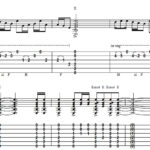Guitar chord theory can seem daunting, and many guitarists shy away from it, preferring to simply learn chord shapes. Like many players, you might be tempted to focus solely on techniques like lead guitar, perhaps inspired by legends such as Stevie Ray Vaughan or Gary Moore. However, neglecting to Study Guitar Chords and rhythm guitar can create a significant gap in your musical foundation.
In my own guitar journey, I initially prioritized lead playing, overlooking the crucial role of chords. It wasn’t until I made a conscious effort to delve into study guitar chords and understand guitar chord theory that I truly began to unlock my potential.
This focused study dramatically improved my overall playing. I gained confidence and fluency in playing a wide variety of guitar chords across the fretboard. More surprisingly, my lead guitar playing also experienced a significant boost.
This improvement stems from the fundamental role chords play in music. Every guitar solo is built upon a chord progression. Therefore, even if your primary interest is lead guitar, understanding chord construction and function is invaluable.
Study guitar chords will empower you to craft more sophisticated and nuanced solos. You’ll learn to play with the underlying harmony, rather than just over it, resulting in more melodic and impactful solos.
Furthermore, if you aspire to write your own music, a basic understanding of guitar chord theory is essential. It provides the tools to create compelling chord progressions that effectively convey your musical ideas.
While guitar chord theory is a vast subject, this article will cover the essential basics. Consider this your starting point for a deeper study guitar chords, providing the foundational knowledge to become more comfortable with chords and their construction. You can then gradually expand your knowledge and take your guitar playing to the next level.
In this guide, we will explore:
It’s important to note that this article is not a collection of chord diagrams for immediate playing. Those will be covered in future resources. Instead, we focus on the theoretical underpinnings. Grasping these concepts will significantly simplify learning and applying different chords in your playing later on.
Whether you aim to enhance your rhythm guitar skills, compose original music, or simply become a more well-rounded musician, I believe you’ll find this guide to study guitar chords incredibly beneficial. Let’s begin with the fundamentals of guitar chord theory.
The Major Scale: The Foundation of Guitar Chords
To effectively study guitar chords and understand their creation, we must first examine the major scale. While it might not immediately seem relevant, the major scale is the bedrock of Western music, including blues, and crucial for understanding guitar chord theory.
If you’re unfamiliar with the major scale, I recommend exploring resources on ‘Getting Started With The Major Scale’ before proceeding. However, let’s briefly recap the essentials.
The major scale is a seven-note scale, and every scale has a specific formula. The major scale formula is:
| 1 | 2 | 3 | 4 | 5 | 6 | 7 |
|---|
Each number represents a note within the major scale – 1 being the root, 2 the second, and so forth. These are also known as ‘degrees’ of the scale. In the key of C major, the notes are:
| C | D | E | F | G | A | B |
|---|
Here’s how the C major scale looks played across the guitar fretboard:
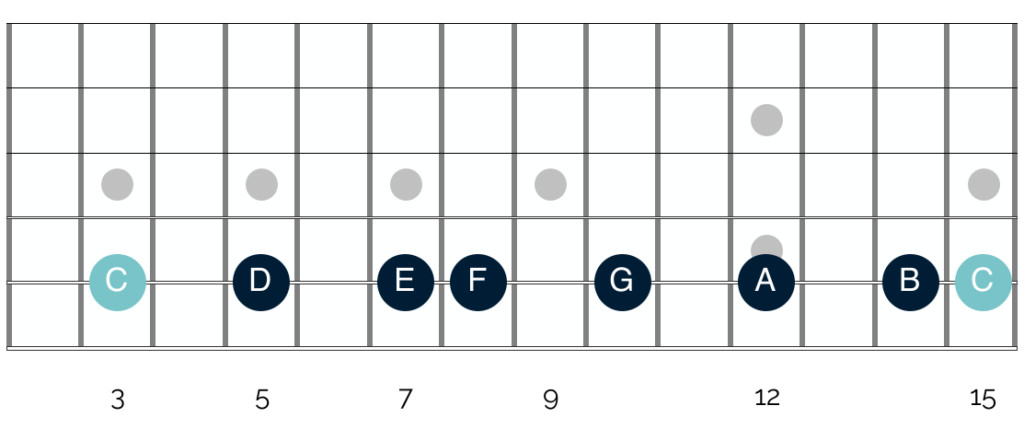 Understanding the major scale is the first step to understanding guitar chord theory
Understanding the major scale is the first step to understanding guitar chord theory
Alt text: C major scale diagram showing notes C, D, E, F, G, A, B on a guitar fretboard, illustrating the foundation for studying guitar chords.
In music theory, a chord is defined as a group of three or more notes played simultaneously. Therefore, to create a chord, we need to stack at least three notes from the major scale together.
However, chord construction isn’t random. There’s a specific logic to it, and while initially complex, understanding this logic will greatly simplify learning and using chords in the long run as you study guitar chords.
Triads: Building Blocks of Chords
The specific notes we stack, the number of notes, and their order determine the type of chord we create. We’ll explore these adjustments later, but let’s start with basic chord construction.
The simplest chord type is a triad, derived from the Latin word for “three.” A triad is a chord composed of three notes, each separated by a musical interval called a third.
If intervals are new to you, it’s beneficial to review resources on guitar intervals before continuing. Intervals are fundamental to understanding how chords work and the relationships between notes on the guitar as you study guitar chords.
Let’s revisit the C major scale:
| Note name | C | D | E | F | G | A | B |
|---|---|---|---|---|---|---|---|
| Scale degree | 1 | 2 | 3 | 4 | 5 | 6 | 7 |
The notes highlighted in yellow (C, E, G) form a C major triad. As mentioned, it contains three notes, each a third apart.
The term “third” can be initially confusing. While C and E are only separated by one scale step (D), and E and G are also separated by one step (F), in musical counting, we include the starting note.
So, counting from C: C (1st), D (2nd), E (3rd). Similarly, from E: E (1st), F (2nd), G (3rd).
Think of it as skipping every other note in the scale: C, skip D, E, skip F, G, and so on.
This is how triads are formed: select three notes from the major scale, each a third apart. Playing them together creates a chord!

Intervals and Triad Variations
Now, the complexity increases depending on which note of the major scale you start on.
Starting on C in the C major scale creates a C major triad. However, this isn’t the case for every note.
This variation is due to intervals. A triad is formed with notes a third apart, but the specific intervals between these notes change the triad’s character as you study guitar chords.
If you’re familiar with the major scale, you know the distances (intervals) between notes are not uniform. This is evident when visualizing the scale on the fretboard:
 Understanding the major scale is the first step to understanding guitar chord theory
Understanding the major scale is the first step to understanding guitar chord theory
Notice the varying fret distances between notes. This becomes crucial when building triads from different scale notes.
While the notes in any triad are a third apart in scale degrees, the actual intervals between them differ, depending on the starting note. Compare a triad starting on C to one starting on D:
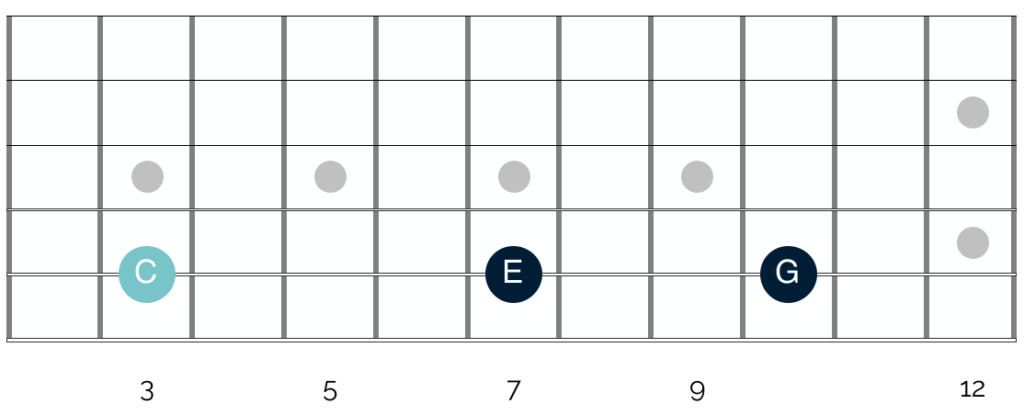 C Major Triad Diagram
C Major Triad Diagram
Alt text: C major triad diagram showing fret intervals between notes C, E, and G, illustrating major triad construction for guitar chord study.
In the C triad (root note C, light blue), there are 4 frets between C and E, and 3 frets between E and G. Between C and G, there are 7 frets.
Each fret represents a semitone. So, C to E is two whole tones, E to G is one and a half tones, and C to G is three and a half tones.
Now compare this to a triad built on D:
 C Major Scale Shapes Diagram
C Major Scale Shapes Diagram
Alt text: D minor triad diagram demonstrating fret intervals between notes D, F, and A, contrasting with major triad intervals in guitar chord study.
Unlike the C triad, the D triad has different intervals. D to F is 3 frets (one and a half tones), and F to A is 4 frets (two tones). However, like the C triad, D to A is still 7 frets or three and a half tones.
Playing the notes of each triad simultaneously results in a C major triad and a D minor triad.
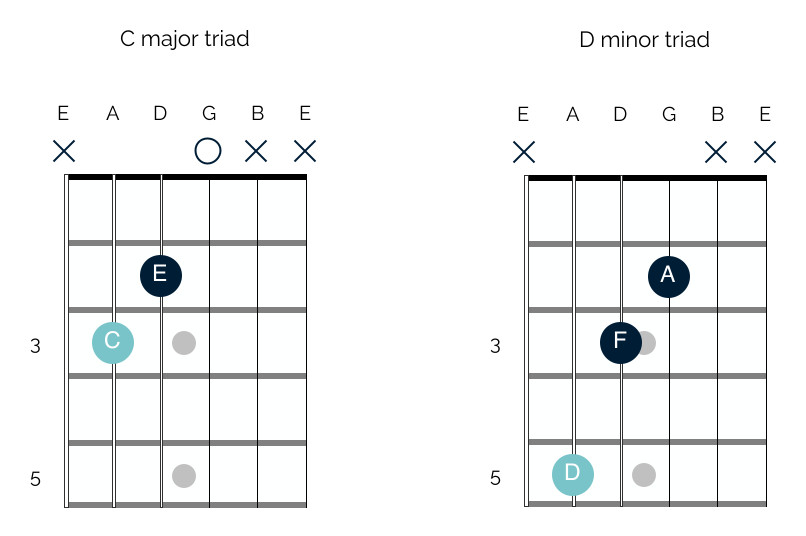 Guitar Chords Diagram
Guitar Chords Diagram
Alt text: Diagram showing C major and G major open chord shapes, examples of common guitar chords to study and learn.
The C major triad utilizes open strings. Instead of fretting G, it’s played on the open G string.
Before diving into the theory behind major and minor chords, play both triads. Listen to the distinct sounds. The major triad sounds bright and happy, while the minor triad has a more somber and melancholic feel.
This difference in sound arises from the varying intervals within each triad. This is a core concept in guitar chord theory and will be explored further as you study guitar chords.
Major and Minor Triads: Defining the Mood
As mentioned, building a triad on C in C major creates a C major triad, while starting on D creates a D minor triad.
Let’s compare their fretboard representations again, focusing on intervals:
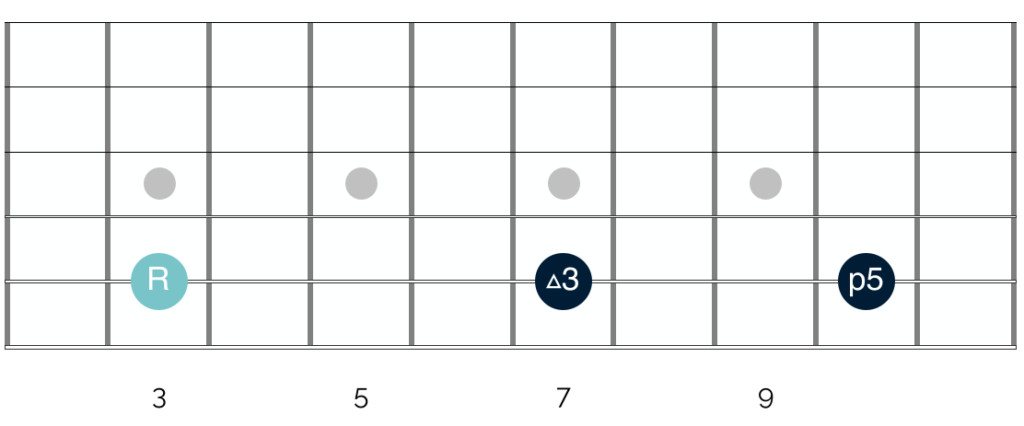 C Major Triad Intervals Diagram
C Major Triad Intervals Diagram
Alt text: C major triad intervals diagram, labeling Root, Major Third, and Perfect Fifth intervals, key components in understanding major guitar chords for study.
This diagram shows the intervals between notes, not just note names. The intervals are:
- Root
- Major third
- Perfect fifth
The first note is always the root, naming the chord. So, a C chord’s root is C, a D chord’s root is D, etc.
A major third is always 4 frets (two whole tones) above the root. This major interval defines the chord’s major quality.
A perfect fifth is always 7 frets (three and a half tones) above the root. Perfect intervals create consonance and resolution, giving the chord a stable, harmonious, and tension-free sound.
Now, let’s compare these intervals to a D minor triad:
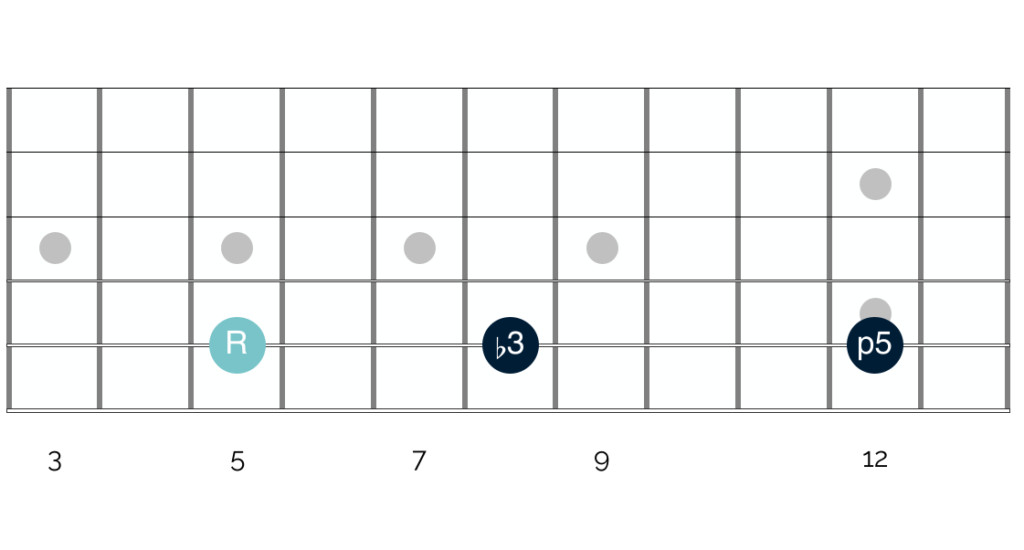 C Major Triad Intervals Diagram
C Major Triad Intervals Diagram
Alt text: D minor triad intervals diagram, labeling Root, Minor Third, and Perfect Fifth intervals, illustrating the structure of minor guitar chords for study.
Again, this diagram shows intervals, not note names. The intervals are:
- Root
- Minor third
- Perfect fifth
Like the major triad, the D minor triad has a root (D) and a perfect fifth. The key difference is the minor third instead of a major third.
A minor third is always 1 fret lower than a major third, and 3 frets (one and a half tones) above the root.
The minor interval gives the chord its minor quality, creating a slightly sad or melancholic sound.
However, like major triads, minor triads also contain a perfect fifth, contributing to a stable and resolved sound, lacking dissonance or tension, despite their downbeat character.
Harmonizing the Major Scale: Unveiling Chord Patterns
The next step in your study guitar chords journey is to apply this triad concept to all notes of the major scale. This reveals the relationship between scale notes and how they stack into different triads.
Let’s revisit the C major scale notes:
| Note name | C | D | E | F | G | A | B |
|---|---|---|---|---|---|---|---|
| Scale degree | 1 | 2 | 3 | 4 | 5 | 6 | 7 |
Starting on C, build a triad by selecting every other note (C, E, G). Repeat this for D, E, and so on.
When you reach F and subsequent notes, continue the same process, looping back to the scale’s beginning notes as needed for the 7th note triad. For example, the F triad is F, A, C, and the G triad is G, B, D.
Keep these interval rules in mind as you study guitar chords:
- Major third: 4 frets above root = major triad.
- Minor third: 3 frets above root = minor triad.
- Perfect fifth: 7 frets above root.
By harmonizing the major scale, you’ll discover two key patterns. First, you’ll produce a combination of major and minor triads. Second, the triad built on the 7th scale degree will sound different from both major and minor triads, as we’ll see below.
Here’s the result of harmonizing the C major scale:
| Note name | C | D | E | F | G | A | B |
|---|---|---|---|---|---|---|---|
| Notes in triad | C E G | D F A | E G B | F A C | G B D | A C E | B D F |
| Type of triad | Major | Minor | Minor | Major | Major | Minor | Diminished |
As you can see, harmonizing the major scale yields three major triads, three minor triads, and one diminished triad.
This pattern is consistent across all major scales, regardless of key (A major, B major, D major, etc.). The specific triads change with the key, but the order of major, minor, and diminished triads remains the same.
This is significant because musicians use this triad order to create chord progressions. We’ll explore this further, but first, let’s examine the diminished triad formed on the 7th degree of the major scale as you continue to study guitar chords.
Diminished Triads: Adding Tension
As you harmonize the major scale, you’ll notice the 7th degree triad behaves differently.
Let’s visualize the B diminished triad on the fretboard:
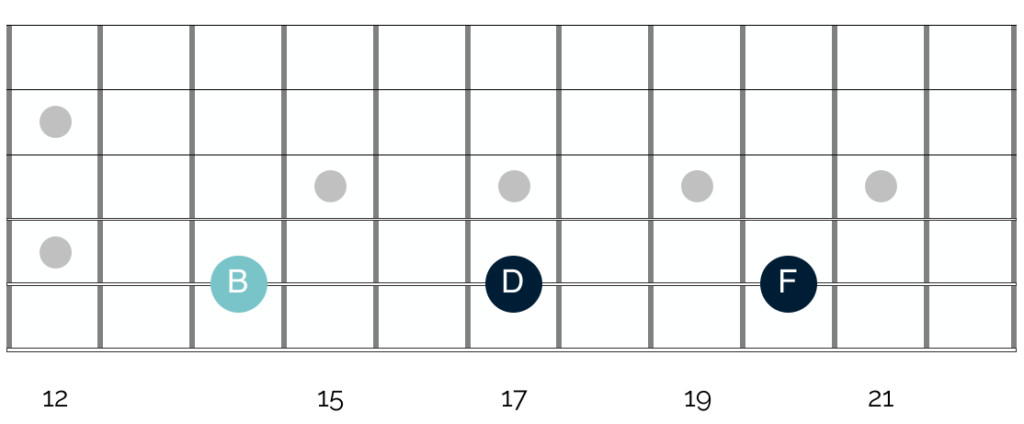 Diminished Triads Diagram
Diminished Triads Diagram
Alt text: B diminished triad diagram showing notes B, D, and F on the fretboard, illustrating diminished chord structure in guitar chord study.
The triad formation seems standard, so why is it diminished instead of major or minor?
The answer lies in the intervals within the triad:
 Diminished Triads Intervals Diagram
Diminished Triads Intervals Diagram
Alt text: B diminished triad intervals diagram, labeling Root, Minor Third, and Flat Fifth intervals, explaining the unique sound of diminished guitar chords for study.
The intervals are:
- Root
- Minor third
- Flat fifth
The root and minor third are the same as in minor triads (3 frets apart). The crucial difference is the “flat fifth.” Instead of a perfect fifth (7 frets), the diminished triad has a flat fifth, only 6 frets from the root (B to F).
This diminished interval creates a tense, dissonant, and unresolved sound, unlike the stable perfect fifth.
Consequently, diminished chords are less common than major and minor triads. While important, you’ll encounter them less frequently in typical chord progressions compared to major and minor chords as you study guitar chords.

Triads and Chords: Practical Application
At this point, you might wonder about the practical application of this theory. Understanding triads is valuable for guitar chord theory, but we need to bridge the gap to practical guitar playing.
So far, we’ve discussed triads in theoretical terms. While essential for understanding guitar chord theory, it can be challenging to connect these concepts to the fretboard.
The term “triad” is more common in theoretical discussions, while beginner and intermediate guitarists are more familiar with the term “chord.”
To clarify, let’s define a triad in relation to a chord and then explore practical usage as you continue to study guitar chords.
As mentioned, a triad is a three-note chord with notes a third apart. Therefore, a triad is a type of chord. All triads are chords, but not all chords are triads.
In practice, this doesn’t limit you to only playing three strings or frets.
Consider the C major triad again:
 C Major Triad Diagram
C Major Triad Diagram
Alt text: Diagram of a C major triad in a basic three-note voicing, representing the fundamental structure of major guitar chords for study.
This diagram shows a triad with just three notes. If you’re new to this, this triad shape might not be common in your playing.
However, you’re likely very familiar with this C major chord shape:
 C Major Chord Diagram
C Major Chord Diagram
Alt text: Diagram of a standard open C major chord shape, a common and practical guitar chord example for study and playing.
Calling the first a “C major triad” and the second a “C major chord” is slightly misleading. The terms are often interchangeable because they contain the same core notes.
The C major triad has notes C, E, and G. The open C major chord also contains C, E, and G.
The only difference is note repetition. The open C chord plays C, E, G, C, and E.
It’s still a C major triad because it contains only three unique notes. This applies to most basic major and minor chords you already know as you study guitar chords.
Let’s look at G major. The G major triad notes are G, B, and D. Here’s a basic G major triad voicing:
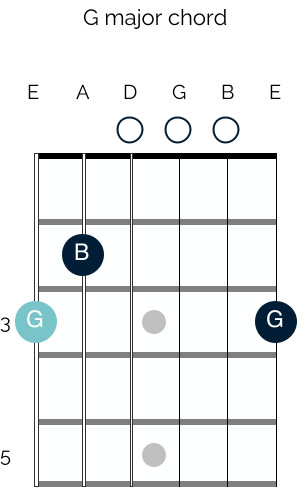 G Major Chord Diagram
G Major Chord Diagram
Alt text: Diagram of a G major chord shape showing the triad notes G, B, and D within a common guitar chord voicing, helpful for guitar chord study.
Here, the pure triad is on the 6th, 5th, and 4th strings (open D string).
But a full G major chord uses all six strings. As the diagram shows, it still only uses triad notes: open G and B strings, and G on the high E string.
Creating Chord Progressions: Music in Motion
Understanding that triads contain the same notes as basic major and minor chords is crucial. It connects theory to chords you’ve likely played since you started learning guitar.
Now, we can combine these chords to form chord progressions.
Let’s revisit our earlier table:
| Note name | C | D | E | F | G | A | B |
|---|---|---|---|---|---|---|---|
| Notes in triad | C E G | D F A | E G B | F A C | G B D | A C E | B D F |
| Type of triad | Major | Minor | Minor | Major | Major | Minor | Diminished |
| Chord | C Major | D Minor | E Minor | F Major | G Major | A Minor | B Diminished |
| Triad / chord number | I | ii | iii | IV | V | vi | vii° |
This table shows the triad order from harmonizing the major scale. I’ve added Roman numerals to number each triad, mirroring scale degree numbering.
Uppercase Roman numerals represent major triads, lowercase for minor triads, and lowercase with a “°” for diminished triads.
Musicians use these chords to create chord progressions. Songs in C major often use chords from this table.
The Beatles’ “Let It Be” is a famous example in C major. The verse chords are C major, G major, A minor, F major, or I, V, vi, and IV chords.
Guitarists often use these Roman numerals to refer to chord progressions. A “one, four, five” progression refers to the I, IV, and V chords.
In a jam session, if you’re told “I, IV, V in C,” you know the progression is C major, F major, G major.
Beyond Basic Guitar Chord Theory: Expanding Your Harmonic Palette
Chord progressions aren’t always simple. Two main factors contribute to this:
First, musicians rarely limit themselves to chords from just one major scale. While a song might be based in a key, songwriters often change keys or “borrow” chords from other keys, adding harmonic color and complexity.
While understanding major scale harmonization is a crucial step in study guitar chords, exploring further theory is needed to fully analyze song structures.
These advanced concepts are beyond this article’s scope but will be covered in future resources. For now, recognize that chord progressions can be more intricate than initially presented.
Second, guitarists often add “chord extensions” to basic triads.
Extensions don’t change the chord’s fundamental quality (major remains major, minor remains minor), but they alter the sound and feel.
These extended chords are prevalent in popular music, such as major 7th, minor 7th, and dominant 7th chords. Like complex chord progressions, chord extensions are a detailed topic requiring further explanation.
The good news is that the guitar chord theory you’ve learned here provides a solid foundation for understanding chord extensions as you continue to study guitar chords.
For now, focus on mastering the guitar chord theory outlined here. It’s complex and theoretical, so don’t worry if it seems challenging initially. Revisit it, apply it to your guitar playing, and with time, it will become clearer.
Good luck! Let me know your progress and any questions you have in the comments or email me at [email protected]. I’m happy to help! 😁
References & Images
Unsplash, Guitar Habits, Wikipedia, Hello Music Theory, Music Notes Now, Wikipedia, Puget Sound, Open Music Theory, Guitar Theory For Dummies, Modern Music Theory For Guitarists

